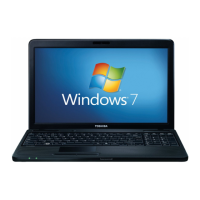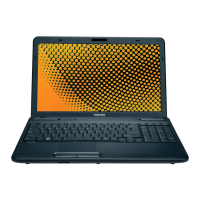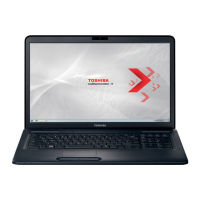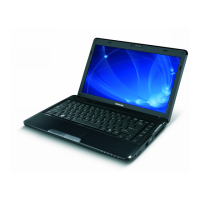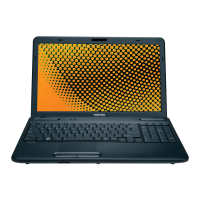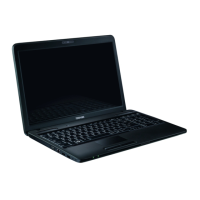
Do you have a question about the Toshiba Satellite C660 Series and is the answer not in the manual?
| RAM | Up to 8GB DDR3 |
|---|---|
| Operating System | Windows 7 Home Premium |
| Optical Drive | DVD SuperMulti Drive |
| Battery | 6-cell Lithium-ion |
| Wireless | 802.11b/g/n |
| Processor | Intel Core i3/i5/i7 or AMD equivalent |
| Display | 15.6-inch HD (1366x768) |
| Graphics | Intel HD Graphics |
| LAN | 10/100 Ethernet |
| Ports | 2 x USB 2.0, VGA, RJ-45, headphone, microphone |
| Weight | Approx. 2.5 kg |
Learn to control the on-screen pointer using fingertip movements on the touchpad.
Use the computer's device for recording video and taking photographs.
Overview of the computer's wireless communication capabilities.
Instructions for connecting and disconnecting to a Local Area Network.
Keyboard shortcuts to enable/disable specific computer features.
Keys with specific Windows functions, like Start menu or context menu.
Information on battery types, use, recharging, and handling.
Utility to set or reset user and supervisor passwords for power-on.
Overview of Shut Down, Hibernation, and Sleep modes.
How to launch the TOSHIBA HW Setup program.
Customizing display settings for internal or external monitors.
Setting the priority for booting the computer.
Guidelines for identifying and resolving computer problems.
Troubleshooting issues with the hard disk drive.
Troubleshooting issues with the touchpad.
Troubleshooting external monitor connection problems.
Provides the computer's physical size specifications.
Details operating and non-operating environmental conditions.
How the display controller interprets commands and controls the screen.
How video mode settings are configured via Screen Resolution.
Compliance of Wireless LAN with IEEE 802.11 standards.
Interoperability of Bluetooth cards with other products.
Information about the Central Processing Unit's performance variations.
Explains how system memory is used and displayed.
Ensure proper airflow around the computer to prevent overheating.
Setting up a safe and suitable workspace for the computer.
Check hardware, documentation, and software included with the computer.
Steps to connect the AC adaptor for powering the computer.
Procedure for turning on the computer's power.
Accessing and using recovery options to repair the system.
Identifies components on the front of the computer when the display is closed.
Identifies ports and vents on the left side of the computer.
Identifies ports on the right side of the computer.
Identifies components on the bottom of the computer.
Identifies components visible when the display is open.
Explains the function of various system indicator lights.
Describes the computer's hardware components.
Describes the computer's internal display panel.
Details about LAN, Bluetooth, and Wireless LAN.
Unique or advanced features for convenience.
Describes pre-installed utilities and how to start them.
Devices to expand computer capabilities and versatility.
Slot accommodating memory media for easy data transfer.
Instructions on installing and removing optional memory modules.
How to connect an external analog monitor.
How to connect an HDMI monitor.
Using a security lock slot to anchor the computer.
Control the on-screen pointer by moving your fingertip on the touchpad.
Device for recording video and taking photographs.
Facial verification for logging into Windows.
Operating CD/DVD-based programs with the drive.
Using DVD Super Multi drive to write data to discs.
Limitations and usage of the disc creation software.
Notes on using the VIDEO PLAYER software.
Describes audio control functions.
Details on Wireless LAN compatibility and standards.
Information on Bluetooth capabilities and features.
Information on built-in Ethernet LAN support.
Guidance on proper handling and maintenance of the computer.
Simple precautions for moving the computer to ensure trouble-free operation.
How the processor temperature is managed to prevent overheating.
Keys at the top of the keyboard that execute programmed functions.
Keyboard shortcuts to enable/disable specific computer features.
Makes the FN key function like a sticky key.
Keys with specific Windows functions, like Start menu or context menu.
How to create ASCII characters using specific codes.
How AC adaptor, battery status affect computer operation.
Methods for checking the remaining battery power.
Tips to maximize the lifespan of battery packs.
How to remove and install the battery pack.
Utility to maintain security levels with user/supervisor passwords.
Steps to start the computer using a user password.
Overview of Shut Down, Hibernation, and Sleep modes.
How to launch the TOSHIBA HW Setup program.
Overview of the HW Setup window tabs and buttons.
Setting or resetting the user password for power-on.
Customizing display settings for internal or external monitors.
Setting the priority for booting the computer.
Guidelines for identifying and resolving computer problems.
Basic checks for common problems before detailed troubleshooting.
Questions to consider when diagnosing malfunctions.
Basic checks for hardware and attached peripherals.
Explains the automatic self-test executed during boot-up.
Checklists for AC power and battery issues.
Troubleshooting issues with the hard disk drive.
Troubleshooting issues with the touchpad.
Troubleshooting external monitor connection problems.
Troubleshooting wireless LAN access issues.
Troubleshooting messages related to Recovery Media creation.
Information on obtaining additional help and technical assistance.
Provides the computer's physical size specifications.
Details operating and non-operating environmental conditions.
How the display controller interprets commands and controls the screen.
How video mode settings are configured via Screen Resolution.
Compliance of Wireless LAN with IEEE 802.11 standards.
Interoperability of Bluetooth cards with other products.
Information about the Central Processing Unit's performance variations.
Explains how system memory is used and displayed.
Steps for registering a theft report by paper.
Steps for registering a theft report online.
Explains formats used for terms and procedures in the manual.
Lists abbreviations used in the document with their definitions.
Ensure proper airflow around the computer to prevent overheating.
Setting up a safe and suitable workspace for the computer.


